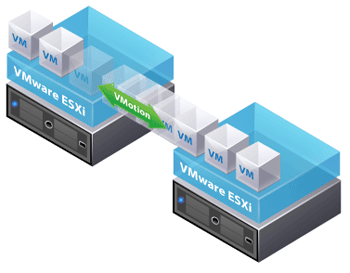VMware vMotion Interview questions
1.What is VMware vMotion?
VMware VMotion enables the live migration of running virtual machines from one physical server to another with zero downtime, continuous service availability, and complete transaction integrity. It is transparent to users.
2. What are the use cases of VMware vMotion ?
- Balance the load on ESX servers (DRS
- Save power by shutting down ESX using DPM
- Perform patching and maintenance on ESX server (Update Manager or HW maintenance
3. What are Pre-requisites for the VMware vMotion to Work?
- ESX host must be licensed for VMotion
- ESX servers must be configured with vMotion Enabled VMkernel Ports.
- ESX servers must have compatible CPU’s for the vMotion to work
- ESX servers should have Shared storage (FB, iSCSI or NFS) and VM’s should be stored on that storage.
- ESX servers should have exact similar network & network names. This restriction has been lifted in vSphere 6 vMotion. You will be able to vMotion across vSwitches and vCenter Servers.
4. What are the Limitations of VMware vMotion?
- Virtual machines configured with the Raw Device Mapping(RDM) for clustering features using vMotion
- VM cannot be connected to a CD-ROM or floppy drive that is using an ISO or floppy image stored on a drive that is local to the host server. The device should be disconnected before initiating the vMotion.
- Virtual Machine cannot be migrated with VMotion unless the destination swapfile location is the same as the source swapfile location. As a best practice, Place the virtual machine swap files with the virtual machine configuration file.
- Virtual Machine affinity must not be set (aka, bound to physical CPUs).
5. Steps involved in VMWare vMotion ?
- A request has been made that VM-1 should be migrated (or “VMotioned”) from ESX A to ESX B.
- VM-1’s memory is pre-copied from ESX A to ESX B while ongoing changes are written to a memory bitmap on ESX A.
- VM-1 is quiesced on ESX A and VM-1’s memory bitmap is copied to ESX B.
- VM-1 is started on ESX B and all access to VM-1 is now directed to the copy running on ESX B.
- The rest of VM-1’s memory is copied from ESX A all the while memory is being read and written from VM-1 on ESX A when applications attempt to access that memory on VM-1 on ESX B.
- If the migration is successful, VM-1 is unregistered on ESX A.
If you are looking for more VMware interview questions on other sections Please take a look at VMware Interview Questions section. I hope this VMware vMotion interview questions will be useful to you. Thanks for Reading!!!. Be social and share it in social media like Google Plus, facebook and twitter, If you feel worth sharing it.


